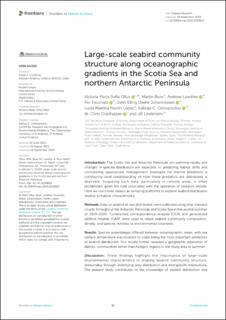| dc.contributor.author | Ollus, Victoria Marja Sofia | |
| dc.contributor.author | Biuw, Martin | |
| dc.contributor.author | Lowther, Andrew | |
| dc.contributor.author | Fauchald, Per | |
| dc.contributor.author | John Elling Deehr, Johannessen | |
| dc.contributor.author | Martín López, Lucía Martina | |
| dc.contributor.author | Gkikopoulou, Kalliopi C. | |
| dc.contributor.author | Oosthuizen, W. Chris | |
| dc.contributor.author | Lindstrøm, Ulf Ove | |
| dc.date.accessioned | 2023-11-03T10:39:10Z | |
| dc.date.available | 2023-11-03T10:39:10Z | |
| dc.date.created | 2023-11-01T14:50:07Z | |
| dc.date.issued | 2023 | |
| dc.identifier.citation | Frontiers in Marine Science. 2023, 10 . | en_US |
| dc.identifier.issn | 2296-7745 | |
| dc.identifier.uri | https://hdl.handle.net/11250/3100485 | |
| dc.description.abstract | The Scotia Sea and Antarctic Peninsula are warming rapidly and changes in species distribution are expected. In predicting habitat shifts and considering appropriate management strategies for marine predators, a community-level understanding of how these predators are distributed is desirable. Acquiring such data, particularly in remote areas, is often problematic given the cost associated with the operation of research vessels. Here we use cruise vessels as sampling platforms to explore seabird distribution relative to habitat characteristics. | en_US |
| dc.language.iso | eng | en_US |
| dc.title | Large-scale seabird community structure along oceanographic gradients in the Scotia Sea and northern Antarctic Peninsula | en_US |
| dc.title.alternative | Large-scale seabird community structure along oceanographic gradients in the Scotia Sea and northern Antarctic Peninsula | en_US |
| dc.type | Peer reviewed | en_US |
| dc.type | Journal article | en_US |
| dc.description.version | publishedVersion | en_US |
| dc.source.pagenumber | 15 | en_US |
| dc.source.volume | 10 | en_US |
| dc.source.journal | Frontiers in Marine Science | en_US |
| dc.identifier.doi | 10.3389/fmars.2023.1233820 | |
| dc.identifier.cristin | 2191149 | |
| cristin.ispublished | true | |
| cristin.fulltext | original | |
| cristin.qualitycode | 1 | |
